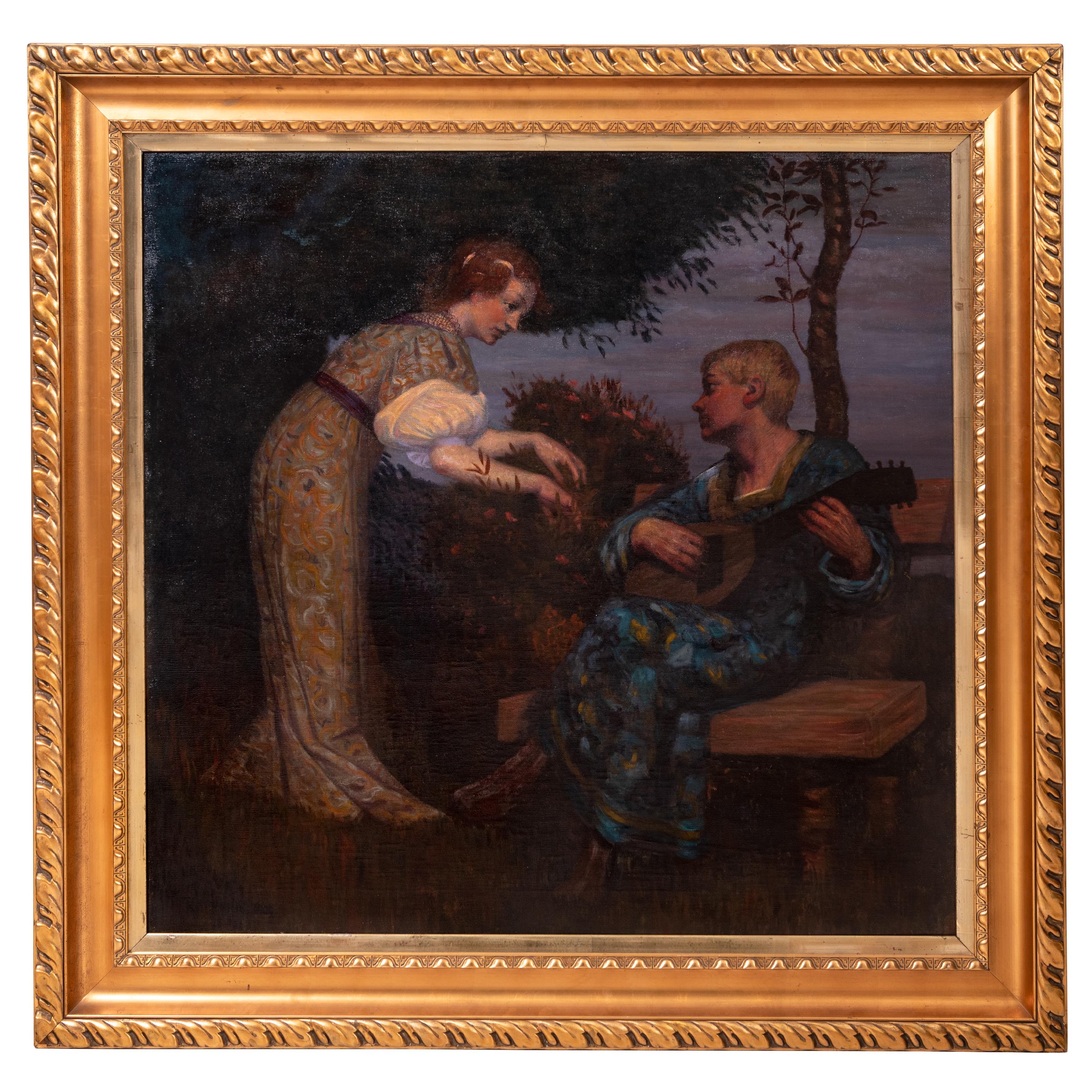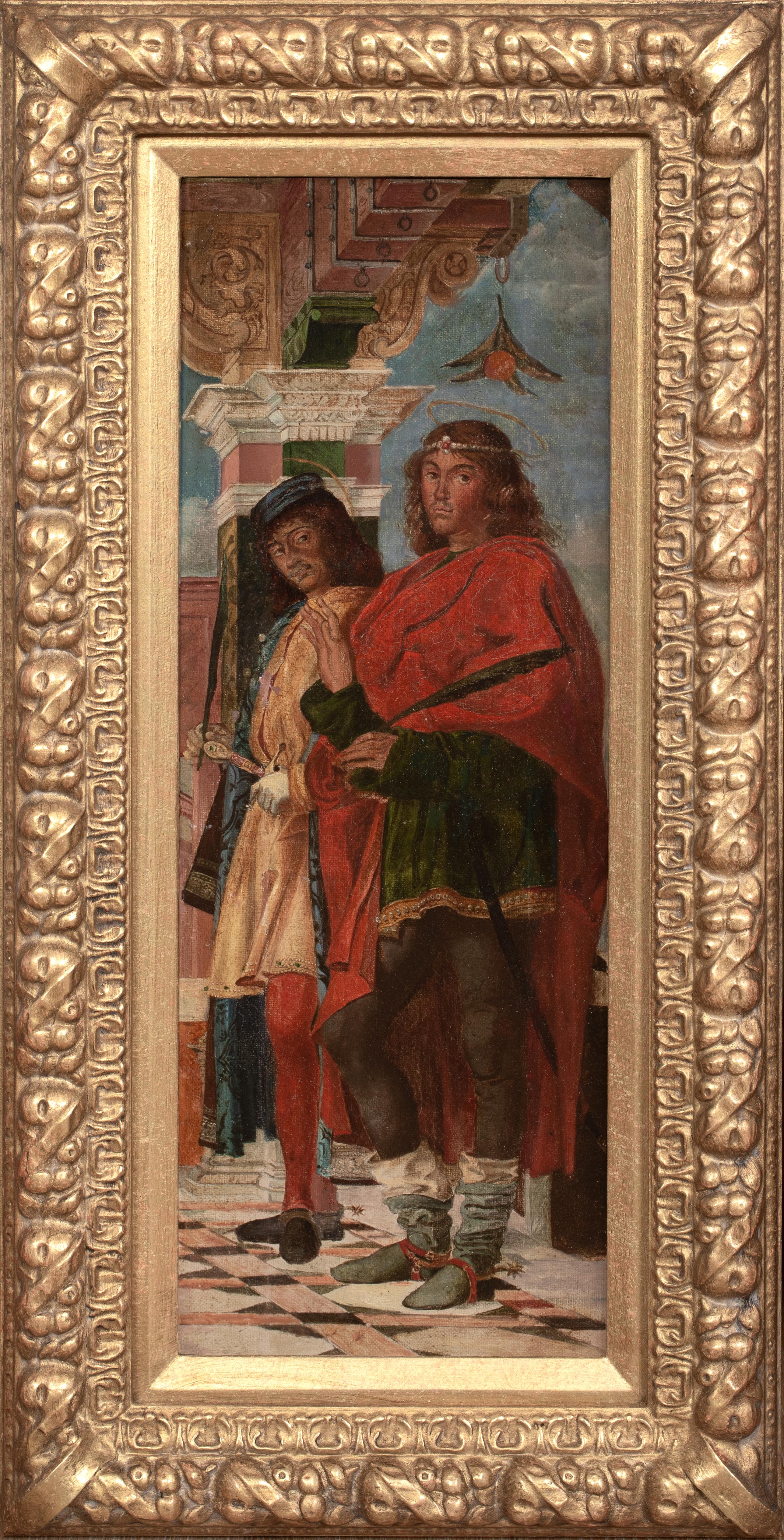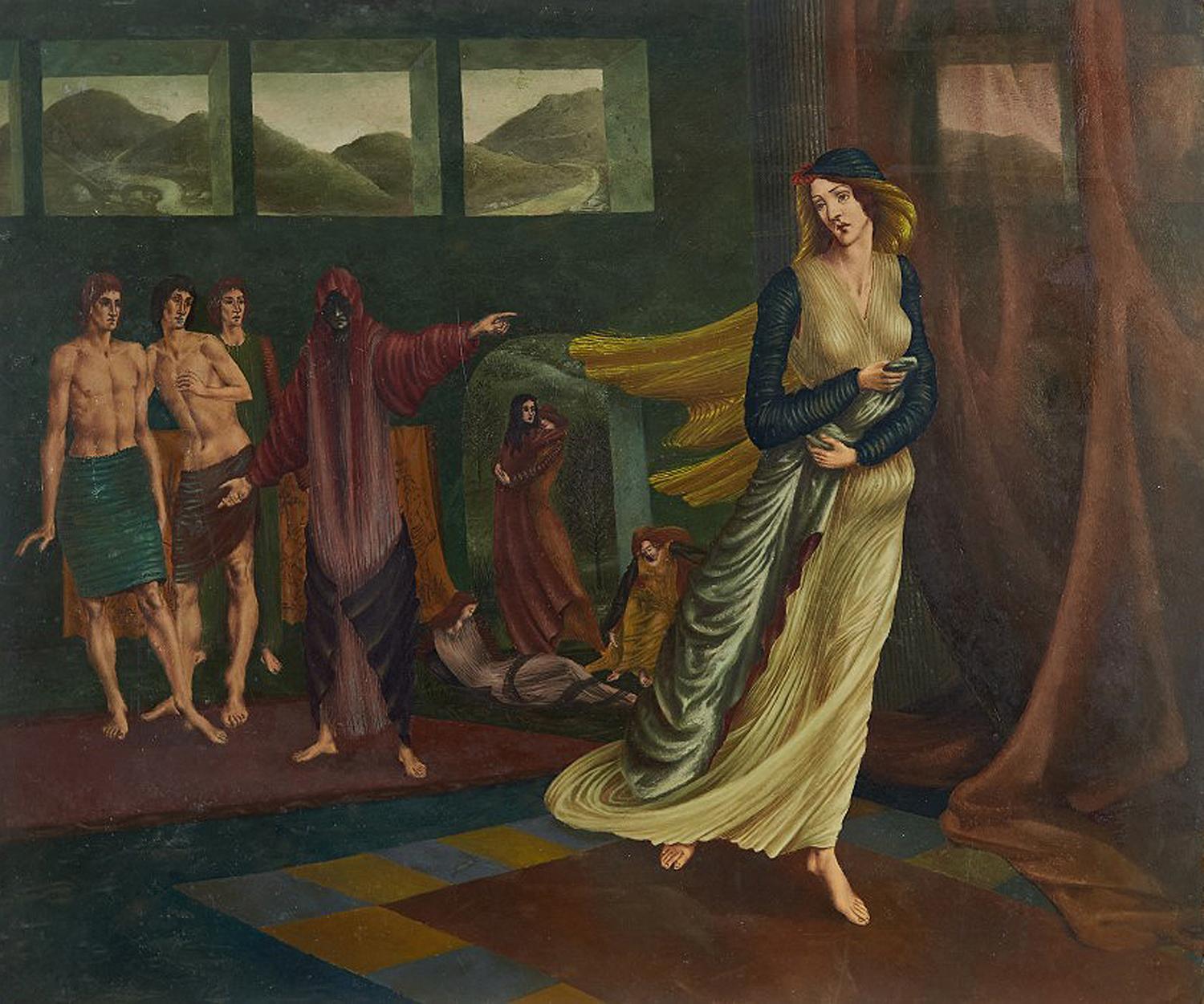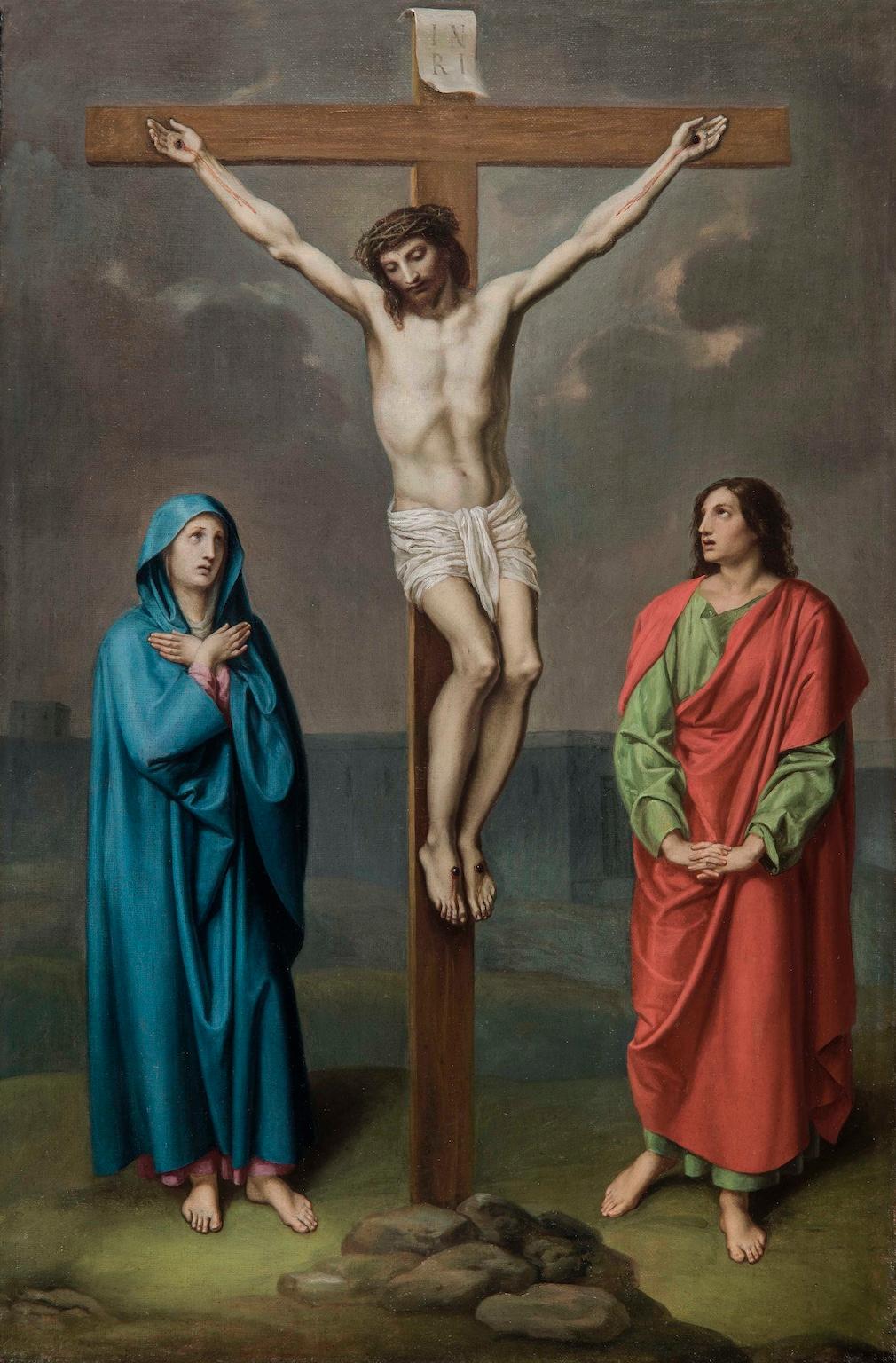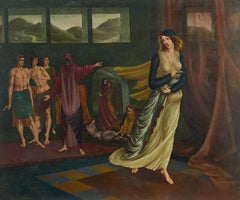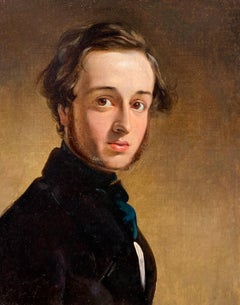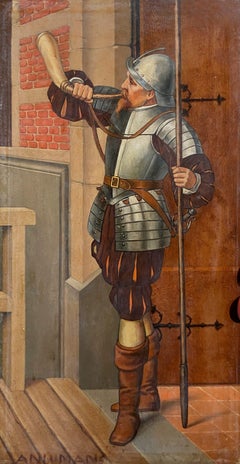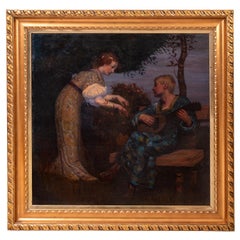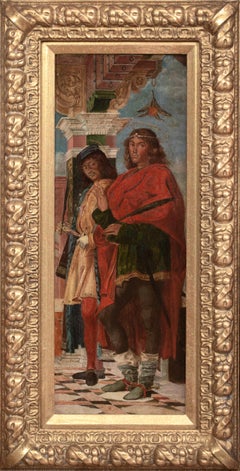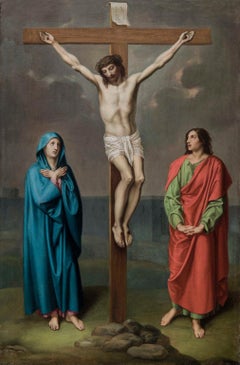Items Similar to Touchstone and Corin, British Pre-Raphaelite 19th Century Oil on Canvas
Want more images or videos?
Request additional images or videos from the seller
1 of 11
Adolphus M. MadotTouchstone and Corin, British Pre-Raphaelite 19th Century Oil on Canvas
$28,148.99
£20,500
€23,992.57
CA$38,833.50
A$42,688.71
CHF 22,435.22
MX$518,396.36
NOK 279,873.80
SEK 265,160.74
DKK 179,062.60
About the Item
Adolphus M. Madot
Circa 1833 - 1861
Oil on canvas
Image size: 36 x 24 inches (91.4 x 61 cm)
Arched Pre-Raphaelite style frame
The subject of the present picture is the dialogue between the court jester Touchstone and the shepherd Corin in the Forest of Arden ( As You Like It, Act III, scene 2). The work of William Shakespeare 'As You Like It' was a popular literary source in Pre-Raphaelite circles, inspiring such artists as John Everett Millais, Walter Howell Deverell and Arthur Hughes. The present picture is comparable in style to the work of Edward W. Rainford and Henry Stacy Marks (1829-1898). Marks' picture Hamlet, Horatio and Osric, shown at the National Institution in 1854 makes a good comparison, as does Rainford's Hotspur and the Courtier (Forbes Magazine Collection; see Shakespeare in Western Art, exhibition circulated in Japan by the Tokyo Shimbun, 1992-3, no. 70, reproduced in catalogue), an illustration to Henry IV, Part 1 which was exhibited at the British Institution in 1852.
The painting is extremely well painted with a great attention to detail such as the ivy climbing the trees or the face on the jesters marotte. This is a rare opportunity to acquire a work by a strong follower of the Pre-Raphaelites.
The Artist
Madot was born in London, his French father taught languages. He enrolled as a student at the Royal Academy Schools and from the little we know of the artist worked chiefly as an illustrator for various editions such as The Art Journal. He sent five pictures to the Royal Academy and other works to the Royal Society of British Artists and the British Institute between the years 1852 and 1862.
It seems Madot was fascinated with the plays of Shakespeare and most his works were inspired by them. One of his paintings was purchased by William Gladstone, a great supporter of the Pre-Raphaelite movement and he acquired many of their pictures.
Sadly this highly talented artist was struck with consumption and died while still in his twenties.
- Creator:Adolphus M. Madot (1833 - 1861, British)
- Dimensions:Height: 36 in (91.44 cm)Width: 24 in (60.96 cm)
- More Editions & Sizes:1 of 1Price: $28,149
- Medium:
- Movement & Style:
- Period:
- Condition:
- Gallery Location:London, GB
- Reference Number:1stDibs: LU5248423162
About the Seller
5.0
Vetted Professional Seller
Every seller passes strict standards for authenticity and reliability
Established in 2007
1stDibs seller since 2014
82 sales on 1stDibs
Typical response time: 4 hours
- ShippingRetrieving quote...Shipping from: London, United Kingdom
- Return Policy
Authenticity Guarantee
In the unlikely event there’s an issue with an item’s authenticity, contact us within 1 year for a full refund. DetailsMoney-Back Guarantee
If your item is not as described, is damaged in transit, or does not arrive, contact us within 7 days for a full refund. Details24-Hour Cancellation
You have a 24-hour grace period in which to reconsider your purchase, with no questions asked.Vetted Professional Sellers
Our world-class sellers must adhere to strict standards for service and quality, maintaining the integrity of our listings.Price-Match Guarantee
If you find that a seller listed the same item for a lower price elsewhere, we’ll match it.Trusted Global Delivery
Our best-in-class carrier network provides specialized shipping options worldwide, including custom delivery.More From This Seller
View AllExiled, Early 20th-Century Pre-Raphaelite Oil on board
By Francis Plummer
Located in London, GB
Francis Plummer
1930 - 2019
Exiled
Oil on board
Image size: 20 ½ x 24 ½ inches
Framed
This rare collection of works from the artists estate, painted i...
Category
Mid-20th Century Pre-Raphaelite Figurative Paintings
Materials
Oil
Self Portrait, 19th Century Pre-Raphaelite Oil Painting
Located in London, GB
Oil on canvas
Image size: 9 1/4 x 7 inches (23.5 x 18 cm)
Original pierced gilt frame
This wonderful Pre-Raphaelite self-portrait contributes to the artistic tradition of representi...
Category
19th Century Pre-Raphaelite Portrait Paintings
Materials
Canvas, Oil
The Palace Guard, Oil on Panel Signed Painting
Located in London, GB
Oil on panel, signed bottom left
Image size: 6 x 11 inches (15.25 x 28 cm)
This painting depicts a 16th century palace guard standing outside of an open door, wearing a set of armou...
Category
19th Century Figurative Paintings
Materials
Oil, Panel
Portrait of William Herbert, 3rd Earl of Pembroke, Early 17th Century Portrait
Located in London, GB
English School, (circa 1600)
Portrait of William Herbert, 3rd Earl of Pembroke
Oil on panel, oval
Image size: 29¼ x 23⅞ inches
Painted wooden frame
Provenance:
176, Collection of Francis Greville, 1st Earl of Warwick.
The Trustees of the Lord Brooks’ Settlement, (removed from Warwick Castle).
Sotheby’s, London, 22nd March 1968, lot 81.
Painted onto wooden panel, this portrait shows a dark haired gentleman in profile sporting an open white shirt. On top of this garments is a richly detailed black cloak, decorated with gold thread and lined with a sumptuous crimson lining. With the red silk inside it’s all very expensive and would fall under sumptuary laws – so this is a nobleman of high degree.
It’s melancholic air conforms to the contemporary popularity of this very human condition, evident in fashionable poetry and music of the period. In comparison to our own modern prejudices, melancholy was associated with creativity in this period.
This portrait appeared in the earliest described list of pictures of Warwick castle dating to 1762. Compiled by collector and antiquary Sir William Musgrave ‘taken from the information of Lord & Lady Warwick’ (Add. MSS, 5726 fol. 3) is described;
‘8. Earl of Essex – an original by Zuccharo – seen in profile with black hair. Holding a black robe across his breast with his right hand.’
As tempting as it is to imagine that this is a portrait of Robert Devereux, the 2nd Earl Essex, we might take this with a pinch of salt. Its identification with this romantic and fatal Elizabethan might well have been an attempt to add romance to Warwick Castle’s walls. It doesn’t correspond all that well with Essex’s portraits around 1600 after his return from Cadiz. Notably, this picture was presumably hung not too far away from the castle’s two portraits of Queen Elizabeth I. The first, and undoubtedly the best, being the exquisite coronation portrait that was sold by Lord Brooke in the late 1970s and now hangs in the National Portrait Gallery. The second, described as being ‘a copy from the original at Ld Hydes’, has yet to resurface.
The portrait eventually ended up being hung in the State Bedroom of Warwick Castle.
Archival documents present one other interesting candidate. The Greville family’s earliest inventory of paintings, made in 1630 at their home Brooke House in Holborn, London, describes five portraits of identified figures. All five belonged to the courtier, politician and poet Sir Fulke Greville (1554-1628), 1st Baron Brooke, and were hung in the ‘Gallerie’ of Brooke House behind yellow curtains. One of them was described as being of ‘Lord of Pembrooke’, which is likely to have been William Herbert (1580-1630), 3rd Earl of Pembroke. William was the eldest son of Greville’s best friend’s sister Mary Sidney, and was brought up in the particularly literary and poetically orientated household which his mother had supported. Notably, the 3rd Earl was one of the figures that Shakespeare’s first folio was dedicated to in 1623.
The melancholic air to the portrait corresponds to William’s own pretensions as a learned and poetic figure. The richness of the robe in the painting, sporting golden thread and a spotted black fabric, is indicative of wealth beyond that of a simple poet or actor. The portrait’s dating to around the year 1600 might have coincided with William’s father death and his own rise to the Pembroke Earldom. This period of his life too was imbued with personal sadness, as an illicit affair with a Mary Fitton had resulted in a pregnancy and eventual banishment by Elizabeth I to Wilton after a short spell in Fleet Prison. His illegitimate son died shortly after being born. Despite being a close follower of the Earl of Essex, William had side-stepped supporting Devereux in the fatal uprising against the Queen and eventually regained favour at the court of the next monarch James I.
His linen shirt is edged with a delicate border of lace and his black cloak is lined on the inside with sumptuous scarlet and richly decorated on the outside with gold braid and a pattern of embroidered black spots.
Despite the richness of his clothes, William Herbert has been presented in a dishevelled state of semi-undress, his shirt unlaced far down his chest with the ties lying limply over his hand, indicating that he is in a state of distracted detachment. It has been suggested that the fashion for melancholy was rooted in an increase in self-consciousness and introspective reflection during the late 16th and early 17th centuries.
In contemporary literature melancholy was said to be caused by a plenitude of the melancholy humor, one of the four vital humors, which were thought to regulate the functions of the body. An abundance of the melancholia humor was associated with a heightened creativity and intellectual ability and hence melancholy was linked to the notion of genius, as reflected in the work of the Oxford scholar Robert Burton, who in his work ‘The Anatomy of Melancholy’, described the Malcontent as ‘of all others [the]… most witty, [who] causeth many times divine ravishment, and a kind of enthusiamus… which stirreth them up to be excellent Philosophers, Poets and Prophets.’ (R. Burton, The Anatomy of Melancholy, London, 1621 in R. Strong, ‘Elizabethan Malady: Melancholy in Elizabethan and Jacobean Portraits’, Apollo, LXXIX, 1964).
Melancholy was viewed as a highly fashionable affliction under Elizabeth I, and her successor James I, and a dejected demeanour was adopted by wealthy young men, often presenting themselves as scholars or despondent lovers, as reflected in the portraiture and literature from this period. Although the sitter in this portrait is, as yet, unidentified, it seems probable that he was a nobleman with literary or artistic ambitions, following in the same vain as such famous figures as the aristocratic poet and dramatist, Edward de Vere...
Category
Early 17th Century Old Masters Portrait Paintings
Materials
Oil, Wood Panel
The Prelude, Early 20th Century Egg Tempera on board
By Francis Plummer
Located in London, GB
Francis Plummer
1930 - 2019
The Prelude
Egg Tempera on board
Image size: 39 ½ x 49 ¼ inches
Original Frame
This work comes from a rare collection of w...
Category
Early 20th Century Figurative Paintings
Materials
Egg Tempera
Mischief, 19th Century British School Signed Oil
Located in London, GB
British School
19th Century
Mischief
Oil on canvas
Image size: 30 x 25 inches
Signed and inscribed indistinctly
Category
19th Century Figurative Paintings
Materials
Canvas, Oil
Price Upon Request
You May Also Like
Antique English Oil Painting 'The Knight Errant' Pre-Raphaelite Nude & Knight
By John Everett Millais
Located in Cirencester, Gloucestershire
The Knight Errant
English School, circa 1900
after the painting by John Everett Millais (1829-1896)
oil painting on board, framed
board: 13 x 10 i...
Category
Early 20th Century Pre-Raphaelite Figurative Paintings
Materials
Oil
Large Antique German Oil Canvas Hermann Frobenius Pre-Raphaelite Painting 1900
Located in Portland, OR
A Large and impressive antique oil on canvas Pre-Raphaelite painting by the German artist, Hermann Frobenius (1871-1954), signed and dated 1900.
Frobenius had classical training and studied both in Rome and Florence, he later was in the circle of Arnold Bocklin and Hans von Marees, he settle in Munich but also in Dresden briefly and latterly in Berlin. He, like many other European painters was fascinated with North Africa and painted many oriental scenes of Algiers, Tunis and Cairo, he was represented at many exhibitions, including the "Great German Art Exhibition" in Munich 1941.
This painting (an early example of the artist's work) is very finely painted in the Pre Raphaelite style, depicting a medieval costumed...
Category
Early 1900s Pre-Raphaelite Figurative Paintings
Materials
Canvas, Oil
Saint Nazarius & Celsus (350AD) after Bartolomeo Montagna (1450-1523)
Located in Blackwater, GB
Saint Nazarius & Celsus (350AD), 18th Century
Diptych Of The Christian Knights & Martyrs after lost work by Bartolomeo Montagna (1450-1523)
Large 18th Century Italian Old Master de...
Category
18th Century Portrait Paintings
Materials
Canvas, Oil
19th century Italian religious purist figurative crucifixion painting
Located in Florence, IT
The painting (oil on canvas 97 x 63 cm, with gilded wooden frame 104 x 71 cm) depicts one of the most dramatic and salient moments in the Christian Catholic religion, namely the cruc...
Category
Early 19th Century Pre-Raphaelite Figurative Paintings
Materials
Canvas, Oil
Charity - Royal Academy exhib. 19thC art Pre-Raphaelite portrait oil painting
By Rudolf Lehmann
Located in Hagley, England
This stunning circular 19th century oil painting is by noted prolific Royal Academy exhibited artist Rudolf Lehmann. A portrait artist, German born Lehmann moved to England in 1866 w...
Category
19th Century Pre-Raphaelite Portrait Paintings
Materials
Oil
$43,939 Sale Price
20% Off
19th Century Pre-Raphaelite Oil Painting of Queen Guinevere King Arthur Camelot
Located in Gerrards Cross, GB
‘Guinevere’ by Norman Prescott-Davies R.B.A, R.C.A. (1861-1915).
Academy Fine Paintings is fully conversant with the latest US Government import duties and the legal exemptions und...
Category
Late 19th Century Pre-Raphaelite Portrait Paintings
Materials
Oil
